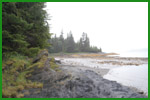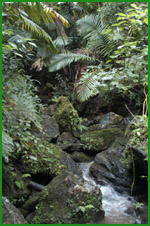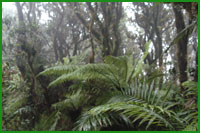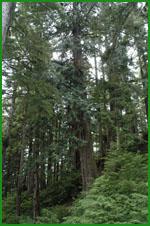|
|
Rain Forest Background
Comparison of Tropical & Temperate Rain Forests
Sometimes you hear the words "tropical" and "temperate" associated with rain forests. The difference is in the location. If the rain forest is close to the equator, it is considered tropical. If the rain forest is farther away from the equator (between the Arctic Circle and the Tropic of Cancer or the Antarctic Circle and the Tropic of Capricorn) then the forest is considered to temperate.
Since Alaska and the Pacific Northwest’s rain forests are found between the Arctic Circle and the Tropic of Cancer, these forests are temperate. All temperate rain forests share similar characteristics, but different plants and animals populate each.
Tropical rain forests are located in the warm regions south of the Tropic of Cancer and north of the Tropic of Capricorn. Tropical rain forests have the greatest biodiversity, but there are non-tropical or temperate rain forests as well (such as those on the northwest coast of the USA). The only tropical rain forest in the United States is found on the island of Puerto Rico.
Rain Forest Recipe
The key ingredients:
- Rain, and lots of it (or other precipitation, i.e. snow, drizzle,
mist, fog . . .). Temperate rain forests receive up to 100 inches
of precipitation/year, while tropical rain forests may receive up
to 400 inches of rain/year.
- Forest (without trees we might have grasslands, but it wouldn't
be rain forest!).
Precipitation and Climate
Both tropical and temperate rain forests are very lush and wet. The tropical rain forest has downpours at the rate of two inches an hour adding up to some 400 inches of rain per year. It rains a lot in the temperate rain forest, too -- about 100 inches per year. And even more moisture comes from the coastal fog that hovers among the trees.
Tropical rain forests are warm and moist; while temperate rain forests are cool.
| Tropical | Temperate |
| Temperatures | warm | cool |
| Number of tree species | many (hundreds) | few (10-20) |
| Types of leaves | broadleaf | needles |
| Age of trees | 50-100 years | 500-1000 years |
| Epiphytes | lots of different kinds including orchids and bromeliads | mostly mosses
and ferns |
| Decomposition rate | rapid | slow |
Temperate Rain Forests
Adapted with permission from The Rain Forests of Home: An Atlas of People and Place (http://www.ecotrust.org/publications/rain_forests_atlas.html), from Ecotrust (http://www.ecotrust.org).
Overview
Coastal temperate rain forests are found in wet, cool climates where the collision of marine air and coastal mountains causes large amounts of rainfall. The worldwide distribution of coastal temperate rain forests has always been limited and today much of their remaining thirty to forty million hectares is located in Chile and along the Pacific Northwest of North America.
These forests stand mainly in watersheds that empty directly into saltwater and, as a result, are fundamentally shaped by the cycling of water and nutrients between land and sea. Organic debris washes out of coastal watersheds, enhancing the productivity of marine ecosystems; salmon and other fish travel inland to spawn and die, transporting valuable nutrients with them. Evidence has been found for 137 animal species that depend upon salmon as a significant part of their diet. Realization of the uniqueness of coastal temperate rain forests has come quite recently. Although scientists have recognized temperate rain forests for over fifty years, the term "coastal" temperate rain forest has a scientific currency of just a decade. Knowledge of these forests and interest in the bioregions where they stand are now growing rapidly.
What Is a Coastal Temperate Rain Forest?

In 1990, ecologists Paul Alaback and James Weigand proposed four features to distinguish coastal rain forests from other temperate forest types: proximity to oceans, the presence of coastal mountains, cooler summer temperatures, and higher rainfall levels with significant precipitation occurring in all seasons. These conditions lead to a unique set of dynamic links between terrestrial and marine ecosystems. In effect, the high tide line does not bound the coastal rain forest ecosystem: the forest influences the abundance and distribution of coastal sea life, and a number of animal species return the favor by carrying marine nutrients back into coastal watersheds.
Where Are They Found?
The largest contiguous coastal temperate rain forest traces the northwestern maritime margin of North America, from Kodiak Island in Alaska south through British Columbia and the U.S. Pacific Northwest to California's "fogbelt" redwoods. Elsewhere in the northern hemisphere, Norway contains small fragments of coastal rain forest, but the forests formerly found along the west coasts of Ireland and Scotland, in parts of Iceland, and in a narrow crescent along the eastern shore of the Black Sea are long gone. Chile contains the Southern Hemisphere's largest remaining coastal temperate rain forest. Significant areas of coastal rain forest also stand on the west coast of New Zealand's South Island and on the Australian island of Tasmania. The forests along the western coast of North America from the redwoods in California to Alaska's Kodiak Island contain approximately half of the remaining worldwide distribution of coastal temperate rain forest. Alaback (1991, 1995) distinguishes four coastal rain forest zones in North America based on temperature and precipitation distribution, which are the primary determinants of the distribution of plants and animals.
Important and Productive
Coastal temperate rain forests foster a hugely disproportionate share of the world's biological production. They accumulate and store more organic matter than any other forest type (including tropical rain forests) - as much as 500-2,000 metric tons of wood, foliage, leaf litter, moss, other living plants, and organic soil per hectare. Some individual trees in temperate rain forests have grown for two millennia and surpass six meters in diameter. The adjacent waters are productive as well. The upwelling zones and cold-water currents that bathe the edges of coastal temperate rain forests account for a substantial share of the biological production of the oceans. The productivity of these marine ecosystems is enhanced by the nutrients and organic debris washed out of the coastal watersheds.
The Status of Temperate Rain Forests
Once found on five continents, coastal temperate rain forests have been modified throughout much of their original range. The North American coastal temperate rain forest, stretching from Northern California to Alaska, accounted for roughly fifty percent of the original global distribution of this forest type. Now, forty-four percent of the North American range has been developed. The impact of this development is abundantly evident from Vancouver Island south. North America's coastal rain forests contain some of the world's most valuable commercial timber lands. Throughout their original distribution, the fecundity and relatively mild maritime climates of coastal temperate rain forest regions have invited heavy exploitation. Coastal rain forests were among the first landscapes logged when Euro-Americans settled North America's Pacific Coast in the 1850s. They have been heavily harvested, particularly in the southern third of the bioregion. Clearcut logging of old-growth conifers remains widespread in this region today, and many rain forest valleys have become industrial tree farms from which trees have already been harvested three times.
Industrial exploitation of the lands and waters of the coastal temperate rain forest has meant secure profits for a relative handful of corporate enterprises but insecure livelihoods for thousands of residents. Communities dependent on logging, mills, and coastal fisheries have seen their prosperity wax and wane with the boom-and-bust cycles typical of raw materials economies. In virtually every stretch of the eight thousand kilometer coastline that supports these forests around the world, residents are seeking to diversify local economies and to capture more of the value of the raw materials harvested and exported from the rain forest fringe.
The growing importance of recreation, tourism, and environmental services in the economies of many coastal areas as well as the recognition that methods of conventional resource extraction deplete natural capital are forcing a reappraisal of resource-based industries and the landscapes they leave behind. New insights into the interdependence of land and sea in the coastal rain forest zone offer further challenges to traditional management practices.
Tropical Rain Forests
Adapted from A Student Guide to Tropical Forest Conservation, USDA Forest Service, Southern Research Station P.O. Box 2680 Asheville, NC 28802
Tropical Rain Forest Overview

The world's tropical forests, which circle the globe, are diverse. Ranging from the steamy jungles of the rain forests to the dry forests and savannas, they provide habitat for millions of species of plants and animals. Once covering some 15.3 billion acres (6.2 billion ha), these tropical forests have been reduced through cutting and clearing by 210 million acres (85 million ha) between 1985 and 1990.
About half of all the world's forests are in the Tropics—the area between the Tropic of Cancer and the Tropic of Capricorn. This region may be best known for its rain forests - lush, steamy jungles with towering trees, epiphytes, and dense under stories of smaller trees, shrubs, and vines.
Not all forests in the tropics are rain forests! Tropical forests are surprisingly diverse. In addition to rain forests, there are mangroves, moist forests, dry forests, and savannas. Such classifications, however, give only a slight indication of the diversity of tropical forests. One study by the Food and Agriculture Organization (FAO) of the United Nations, which considered 23 countries in tropical America, 37 in tropical Africa, and 16 in tropical Asia, identified dozens of types of tropical forests: open and closed canopy forests, broadleaved trees and conifer forests, closed forests and mixed forest grasslands, and forests where agriculture has made inroads.
The largest remaining areas of tropical rain forests are in Brazil, Congo, Indonesia, and Malaysia. Precipitation generally exceeds 60 inches (150 cm) per year and may be as high as 400 inches (1000 cm). Giant trees may tower 200 feet (60 m) in height and support thousands of other species of plants and animals. Montane (mountain) rain forests grow at higher elevations where the climate is too windy and wet for optimum tree growth.
Mangrove forests grow in the swampy, intertidal margin between sea and shore and are often considered part of the rain forest complex. The roots of mangrove trees help stabilize the shoreline and trap sediment and decaying vegetation that contribute to ecosystem productivity.
Dry Forests
Large areas of tropical dry forests are found in India, Australia, Central and South America, the Caribbean, Mexico, Africa, and Madagascar. Dry forests receive low rainfall amounts, as little as 20 inches (50 cm) per year, and are characterized by species well adapted to drought. Trees of dry tropical forests are usually smaller than those in rain forests, and many lose their leaves during the dry season. Although they are still amazingly diverse, dry forests often have fewer species than rain forests.
Savanna is a transitional type between forest and grassland. Trees are often very scattered and tend to be well adapted to drought and tolerant of fire and grazing. If fire is excluded, trees eventually begin to grow and the savanna is converted to dry forest. With too much fire or grazing, dry forest becomes savanna. This vegetation type has fewer species of trees and shrubs but more grasses and forbs than other forest types in the tropics.
All forests have both economic and ecological value, but tropical forests are especially important in global economy. These forests cover less than 6 percent of the Earth's land area, but they contain the vast majority of the world's plant and animal genetic resources. The diversity of life is astonishing. The original forests of Puerto Rico, for example, contain more than 500 species of trees in 70 botanical families. By comparison, temperate forests have relatively few. Such diversity is attributed to variations in elevation, climate, and soil, and to the lack of frost.
Wood and Other Products

Tropical forests provide many valuable products including rubber, fruits and nuts, meat, rattan, medicinal herbs, floral greenery, lumber, firewood, and charcoal. Such forests are used by local people for subsistence hunting and fishing. They provide income and jobs for hundreds of millions of people in small, medium, and large industries.
Tropical forests are noted for their beautiful woods. Four important commercial woods are mahogany, teak, melina, and okoume. Honduras mahogany (Swietenia macrophylla), grows in the Americas from Mexico to Bolivia. A strong wood of medium density, mahogany is easy to work, is long lasting, and has good color and grain. Teak is native to Southeast Asia and India. It is commonly used for furniture, molding, paneling and trim. Its wood has medium density, is strong, polishes well, and has a warm yellow-brown color. Also prized for resistance to insects and rot, teak is commonly used in cabinets, trim, flooring, furniture, and boats. Melina (Gmelina arborea) grows naturally from India through Vietnam. Noted for fast growth, melina has light colored wood that is used mainly for pulp and particleboard, matches and carpentry. Okoume (Aucoumea klaineana) is native to Gabon an the Congo in west Africa. A large fast-growing tree, the wood has moderately low density, good strength-to density ratio, and low shrinkage during drying. It is commonly use (for plywood, paneling, interior furniture parts, and light construction).
Other Economic Values
Tropical forests are home for tribal hunter-gatherers whose way of life has been relatively unchanged for centuries. These people depend on the forests for their livelihood. More than 2.5 million people also live in areas adjacent to tropical forests. They rely on the forests for their water, fuelwood, and other resources and on its shrinking land base for their shifting agriculture. For urban dwellers, tropical forests provide water for domestic use and hydroelectric power. Their scenic beauty, educational value, and opportunities for outdoor recreation support tourist industries.
Many medicines and drugs come from plants found only in tropical rain forests. Some of the best known are quinine, an ancient drug used for malaria; curare, an anesthetic and muscle relaxant used in surgery; and rosy periwinkle, a treatment for Hodgkin's disease and leukemia. Research has identified other potential drugs that may have value as contraceptives or in treating a multitude of maladies such as arthritis, hepatitis, insect bites, fever, coughs, and colds. Many more may be found. In all, only a few thousand species have been evaluated for their medicinal value.
Environmental Benefits
Tropical forests do more than respond to local climatic conditions; they actually influence the climate. Through transpiration, the enormous number of plants found in rain forests return huge amounts of water to the atmosphere, increasing humidity and rainfall, and cooling the air for miles around. In addition, tropical forests replenish the air by utilizing carbon dioxide and giving off oxygen. By fixing carbon they help maintain the atmospheric carbon dioxide levels low and counteract the global "greenhouse" effect.
Forests also moderate stream flow. Trees slow the onslaught of tropical downpours, use and store vast quantities of water, and help hold the soil in place. When trees are cleared, rainfall runs off more quickly, contributing to floods and erosion.
Status of Tropical Rain Forests
Before the dawn of agriculture approximately 10,000 years ago, forests and open woodland covered about 15.3 billion acres (6.2 billion ha) of the globe. Over the centuries, however, about one-third of these natural forests has been destroyed. According to a 1982 study by FAO, about 27.9 million acres (11.3 million ha) of tropical forests are cut each year-an area about the size of the states of Ohio or Virginia. Between 1985 and 1990, an estimated 210 million acres (85 million ha) of tropical forests were cut or cleared. In India, Malaysia, and the Philippines, the best commercial forests are gone, and cutting is increasing in South America. If deforestation is not stopped soon, the world will lose most of its tropical forests in the next several decades.
Reasons for Deforestation
Several factors are responsible for deforestation in the Tropics: clearing for agriculture, fuelwood cutting, and harvesting of wood products. By far the most important of these is clearing for agriculture. In the Tropics, the age-old practice of shifting, sometimes called "slash-and-burn," agriculture has been used for centuries. In this primitive system, local people cut a small patch of forest to make way for subsistence farming. After a few years, soil fertility declines and people move on, usually to cut another patch of trees and begin another garden.
In the abandoned garden plot, the degraded soil at first supports only weeds and shrubby trees. Later, soil fertility and trees return, but that may take decades. As population pressure increases, the fallow (rest) period between cycles of gardening is shortened, agricultural yields decrease, and the forest region is further degraded to small trees, brush, or eroded savanna. Conversion to sedentary agriculture is an even greater threat to tropical forests. Vast areas that once supported tropical forests are now permanently occupied by subsistence farmers and ranchers and by commercial farmers who produce sugar, cocoa, palm oil, and other products.
In many tropical countries there is a critical shortage of firewood. For millions of rural poor, survival depends on finding enough wood to cook the evening meal. Every year more of the forest is destroyed, and the distance from home to the forest increases. Not only do people suffer by having to spend much of their time in the search for wood, but so does the land. Damage is greatest in dry tropical forests where firewood cutting converts forests to savannas and grasslands.
The global demand for tropical hardwoods, an $8-billion-a-year industry, also contributes to forest loss. Tropical forests are usually selectively logged rather than clear-cut. Selective logging leaves the forest cover intact but usually reduces its commercial value because the biggest and best trees are removed. Selective logging also damages remaining trees and soil, increases the likelihood of fire, and degrades the habitat for wildlife species that require large, old trees-the ones usually cut. In addition, logging roads open up the forests to shifting cultivation and permanent settlement.
In the past, logging was done primarily by primitive means-trees were cut with axes and logs were moved with animals such as oxen. Today the use of modern machinery--chain saws, tractors, and trucks -makes logging easier, faster, and potentially more destructive.
Endangered Wildlife
Forests are biological communities-complex associations of trees with other plants and animals that have evolved together over millions of years. Because of the worldwide loss of tropical forests, thousands of species of birds and animals are threatened with extinction. The list includes many unique and fascinating animals, among them the orangutan, mountain gorilla, manatee, jaguar, and Puerto Rican parrot. Although diverse and widely separated around the globe, these species have one important thing in common. They, along with many other endangered species, rely on tropical forests for all or part of their habitat.
Orangutans (Pongo pygmaeus) are totally dependent on small and isolated patches of tropical forests remaining in Borneo and Sumatra, Indonesia. Orangutans spend most of their time in the forest canopy where they feed on leaves, figs and other fruit, bark, nuts, and insects. Large trees of the old-growth forests support woody vines that serve as aerial ladders, enabling the animals to move about, build their nests, and forage for food. When the old forests are cut, orangutans disappear.
The largest of all primates, the gorilla, is one of man's closest relatives in the animal kingdom. Too large and clumsy to move about in the forest canopy, the gorilla lives on the forest floor where it forages for a variety of plant materials. Loss of tropical forests in central and west Africa is a major reason for the decreasing numbers of mountain gorillas (Gorilla gorilla). Some habitat has been secured, but the future of this gentle giant is in grave danger as a result of habitat loss and poaching.
The jaguar (Leo onca), a resident of the Southwestern United States and Central and South America, is closely associated with forests. Its endangered status is the result of hunting and habitat loss.

The Puerto Rican parrot (Amazona vittata), a medium-sized, green bird with blue wing feathers, once inhabited the entire island of Puerto Rico and the neighboring islands of Mona and Culebra. Forest destruction is the principal reason for the decline of this species. Hunting also contributed. Today, only a few Puerto Rican parrots remain in the wild and their survival may depend on the success of a captive breeding program.
In addition to species that reside in tropical forests year round, others depend on such forests for part of the year. Many species of migrant birds journey 1,000 miles or more between their summer breeding grounds in the north and their tropical wintering grounds. These birds are also threatened by tropical forest destruction.
New Directions in Tropical Forestry
The conservation issues of the past seem simple compared with those of today. As we move toward the 21st century, human societies are concerned with global warming, deforestation, species extinction, and rising expectations. Growing populations must be fed, clothed, and sheltered, and people everywhere want higher standards of living.
Global Warming

Warming of the earth's atmosphere is a major environmental issue. Air pollution, deforestation, and widespread burning of coal, oil, and natural gas have increased atmospheric concentrations of carbon dioxide, methane, nitrous oxide, and chlorofluorocarbons. These gases trap heat from the sun and prevent it from radiating harmlessly back into space. Thus, the 64 greenhouse" or warming effect is created.
Because of natural variations in climate, it is difficult to measure warming over large areas. Scientists agree, however, that increases in atmospheric concentrations of greenhouse gases will cause higher temperatures worldwide. Even an increase of a few degrees might cause serious melting of the polar icecaps, a gradual rise in sea level, a disruption in normal weather patterns, a possible increase in forest fires, and the extinction of species.
Role of Forests
Trees, the largest of all land plants, act as a kind of environmental "buffer" for the ecosystem they dominate. They help ameliorate the extremes of climate (heat, cold, and wind) and create an environment where large land mammals, including people, can live comfortably. Trees complement animals in the global environment. Mammals take in oxygen from the air and exhale carbon dioxide. Plants use the carbon dioxide in their growth processes, store the carbon in woody tissues, and return oxygen to the atmosphere as a waste product. This process, known as photosynthesis, is essential to life. Carbon captured from the atmosphere by photosynthesis is eventually recycled through the environment in a process known as the carbon cycle. Trees have an especially important role in the carbon cycle. Tree leaves also act as filters to remove atmospheric pollutants from the air. This effect is particularly beneficial in urban areas.
Forestry Issues

Two key issues will dominate forestry in the years ahead: (1) maintaining long-term productivity of managed forests, and (2) preventing further loss of tropical forests. Both problems will require new approaches to forest management. Traditionally, forestry has focused on growing crops of wood in plantations or in managed natural stands. In this "agricultural mode," other benefits of forest such as watershed protection, wildlife habitat, climate moderation, and outdoor recreation, have received less attention than wood production.
Perhaps more importantly, the sustainability of the full range of forest benefits has not been measured. There is no question that trees can be grown for crops of wood in managed stands. With intensive management-short rotations, species selection, genetic improvement, fertilization, thinning, and other cultural treatments-more wood can be produced in less time than in natural forests. But for how long? And at what cost in other benefits?
As more and more of the world's original forests have been cut, the ecological value of forests has come to be more appreciated. In recent years, increased emphasis has been put on what some are calling "ecosystem management." In this model, the health and long-term stability of the forest are paramount, and timber production is considered a byproduct of good forest management rather than the principal product. In Puerto Rico, for example, wood production is a relatively minor aspect of forestry.
Since the 1930's when timber harvests were curtailed, the forests have been managed primarily for watershed protection, wildlife habitat, and outdoor recreation.
There are no easy solutions to the problem of tropical forest destruction, but most experts agree that the problems cannot be solved simply by locking up the forests in reserves. The forests are too important to local people for that to be a workable solution. There is no doubt that tropical forests will be cut. It is better for them to be cut in an ecologically sound manner than to be cleared for poor-quality farmland or wasted by poor harvest practices.
The only real long-term solutions are: (1) more efficient agriculture on suitable farmland, (2) efficient forestry practice including plantations, and (3) reserves to protect species and ecosystems. Many forestry experts believe that we have only begun to tap the potential for wise use of tropical forests. Many uses have yet to be fully explored. We are only starting to learn the value of tropical forests for medicines, house and garden plants, food and fiber, tourism, and natural resource education.
|








